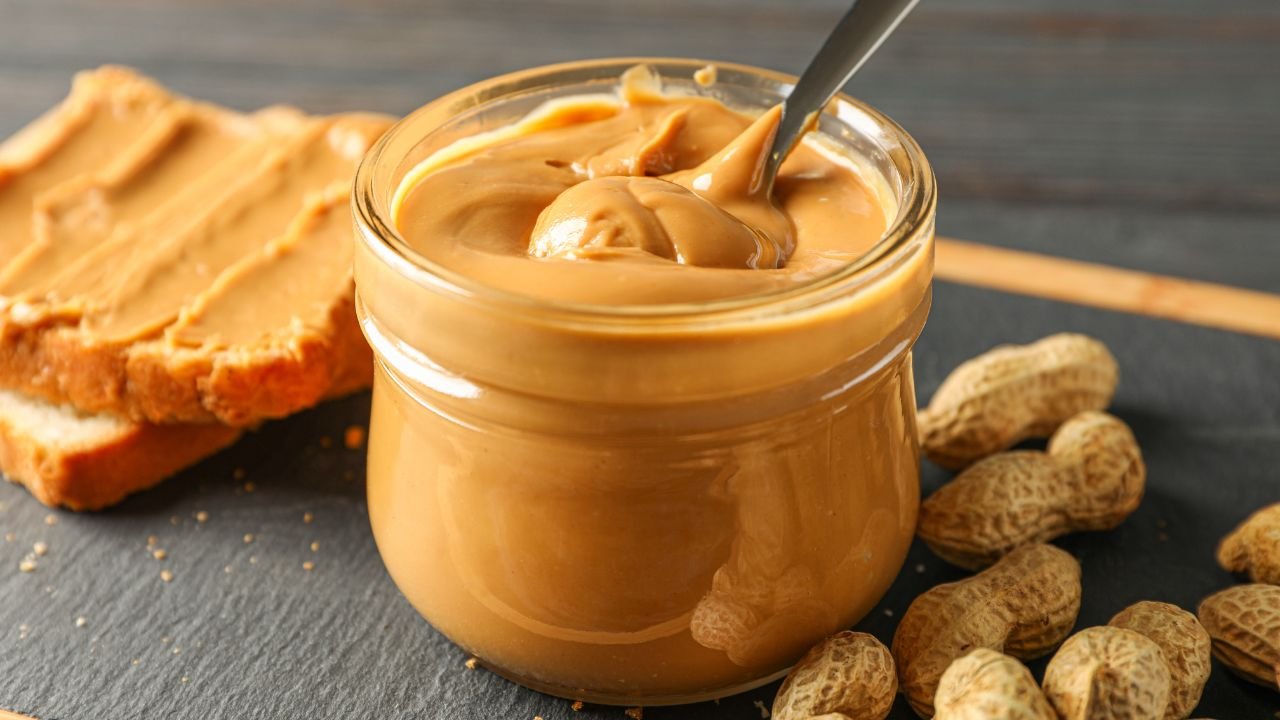Peanut butter, a popular spread known for its rich flavor and creamy (or sometimes crunchy) texture, is enjoyed by people all over the world. This versatile food made from ground peanuts has been a staple in many households for its convenience and deliciousness. Its origins trace back to ancient times, and it has since evolved with various methods of production, which have helped it become a global sensation.

While many savor it for its taste, it also offers a host of nutritional benefits. It is a significant source of protein and contains healthy fats that contribute to heart health when consumed in moderation. The spread is abundantly rich in various vitamins and minerals, solidifying its reputation as a nutritious choice for a well-rounded diet. However, like any food, it’s most beneficial as part of a balanced intake, considering its calorie density and presence of added sugars or fats in certain brands.
Consumer choice is vast, with a range of options varying from natural and organic to commercial versions with additional ingredients. It also finds its way into an array of recipes beyond the classic peanut butter and jelly sandwich, from savory dishes to sweet desserts, showing its impressive culinary flexibility.
Table of Contents
History and Processing of Peanut Butter
In tracing the journey of peanut butter, one finds a blend of ingenuity and technological advancement. From its patented origins to the modern methods of production, the processing of peanut butter reflects a commitment to preserving its beloved taste and texture.
The Origin of Peanut Butter
The story of peanut butter begins with Ambrose Straub, an inventor who patented a peanut butter making machine in the early 1900s. This machine addressed the problem of making peanut butter easily accessible by using heated surfaces to create a more stable product from roasted peanuts. Canadian pharmacist Marcellus Gilmore Edson took a step further in 1884 by obtaining the first patent for a process that produced what was then called peanut paste, a predecessor to what we now know as peanut butter.
Peanuts themselves have been a valuable food source for thousands of years and were processed by ancient civilizations. However, it was not until these modern inventions that peanut butter could be mass-produced and kept from separating, a common issue in earlier varieties.
Modern Manufacturing Processes
Today, the manufacturing of peanut butter has become an intricate process that ensures the creamy spread maintains its consistency and flavor. Raw peanuts are harvested, sorted, and then roasted to develop a rich flavor profile. Once cooled, they are sent to a food processor where they are ground into butter. A critical innovation in this process was introduced by chemist Joseph Rosefield in 1922, who invented a method to prevent the peanut oil from separating by using partially hydrogenated oil, his invention significantly contributed to the modern peanut butter industry.
Modern peanut butter processing often involves additional stages such as blanching to remove the skins, and additional grinding for a smooth texture. Throughout this journey from raw peanuts to the spread that so many love today, technology has played an indispensable role in ensuring that peanut butter is not only delicious but also has the shelf life and texture that consumers expect.
Nutritional Content
Peanut butter is a nutrient-dense food, with each serving providing a significant amount of essential nutrients, including macronutrients, vitamins, and minerals. It is an energy-rich food that contains a variety of compounds beneficial for health.
Macronutrients and Calories
Peanut butter offers a hearty amount of macronutrients. A standard 2-tablespoon serving typically contains:
- Calories: Approximately 190 calories.
- Protein: Roughly 7 to 8 grams, contributing to muscle maintenance and growth.
- Total Fat: Around 16 grams, with a balance of different fatty acids.
- Saturated Fats: Generally about 3.2 grams, which should be consumed in moderation.
- Monounsaturated Fats: Close to 8 grams, known for supporting heart health.
- Polyunsaturated Fats: Usually around 4.5 grams, including essential omega-6 fatty acids.
- Carbohydrates: About 7 grams, with a minimal impact on blood sugar spikes.
- Fiber: About 2 grams, aiding in digestion and satiety.
- Sugar: Varies by brand, though naturally contains about 2 to 3 grams.
Its balanced mix of protein and fats, combined with its fiber content, helps in feeling full and satisfied, making it an excellent food for managing hunger.
Vitamins and Minerals
Peanut butter is not just rich in macronutrients; it also contains various vitamins and minerals crucial for overall health:
- Vitamin E: A potent antioxidant crucial for maintaining skin health and supporting the immune system.
- Niacin (Vitamin B3): Essential for energy metabolism and nervous system function.
- Vitamin B6: Involved in enzyme reactions within the body, including neurotransmitter synthesis.
- Folate: Important for cell growth and metabolism.
- Magnesium: Supports muscle and nerve function and is also critical for a healthy immune system.
- Phosphorus: Works with calcium to help build strong bones and teeth.
- Potassium: An electrolyte that is important for heart function and regulating blood pressure.
- Zinc: Necessary for immune function, DNA synthesis, and cell division.
- Iron: Critical for transporting oxygen in the blood.
This composition of nutrients makes it a healthy option when consumed in moderation as part of a balanced diet.
Health Impact
Peanut butter can have various effects on health, influenced by its components such as healthy fats, including oleic acid, and antioxidants. It is important to consider its impact on cardiovascular health, weight management, diabetes, and potential allergic reactions.
Cardiovascular Health
Consuming peanut butter in moderation may contribute positively to cardiovascular health. It contains oleic acid, a monounsaturated fat that can help maintain healthy cholesterol levels and potentially lower the risk of heart disease. It also contains resveratrol, an antioxidant associated with heart health.
Weight Management and Diabetes
Its high protein and healthy fat content can help with feeling full, which can aid in weight management. However, it is calorie-dense, which requires mindful consumption to prevent obesity. Additionally, while it can be part of a diabetes-friendly diet due to its low carbohydrate content, it’s important to monitor portion sizes as it can impact blood sugar levels.
Peanut Allergies
Peanut butter can be a serious allergen for some individuals. Allergic reactions can range from mild, such as hives and swelling, to severe, like anaphylaxis, which requires immediate medical attention. Those with peanut allergies or sensitivities should avoid this to prevent symptoms like wheezing and other respiratory issues.
Consumer Guide
In this guide, consumers will learn how to select peanut butter that aligns with their preferences and understand the significance of labeling to make informed choices.
Choosing the Right Peanut Butter
When examining brands, consumers are faced with a broad range of options. They must consider whether they prefer smooth peanut butter for a creamy texture or crunchy peanut butter for added bite. Natural peanut butter, often containing fewer additives, may separate, leading to oil at the top that requires stirring. Alternatives to traditional peanut butter include nut butters such as almond butter and cashew butter, which might offer different nutritional benefits.
Ingredients play a critical role in the health profile of peanut butter. Conventional products might include vegetable oil or additives to maintain consistency and longevity, while some may opt for homemade peanut butter to control these elements. Look for brands with minimal ingredients like peanuts and salt. If added sugar is a concern, read labels carefully to avoid excess sweeteners.
| Type | Ingredients | Notes |
|---|---|---|
| Natural | Peanuts, salt, possibly oil | Oil separation is common, stir before using. |
| Conventional | Peanuts, sugar, oils | Smooth, often has more additives for shelf stability. |
| Nut alternatives | Varies by nut | Different flavors and nutritional profiles. |
Understanding Labels
Labels are the gateway to understanding the nutritional content and ingredient composition of peanut butter. Words such as “all-natural” or “no stir” might not always mean what you think. “Natural” suggests minimal processing but doesn’t guarantee the absence of added sugars or oil. “No stir” often implies the inclusion of stabilizers.
Pay attention to the sodium content listed on the label, as some can be high in salt, which affects heart health. Sweeteners are also a frequent addition. If it lists ingredients like honey, molasses, or high-fructose corn syrup, it contains sweeteners. For the purest form, seek out labels that list only peanuts and perhaps a bit of salt.
Nutrition facts are just as important. They can give insights into caloric content, fat ratios—including saturated and unsaturated—fiber, and protein levels. Comparing these among different brands and varieties can guide consumers towards a healthier choice that fits their diet.
Usage in Cooking and Recipes

Peanut butter’s versatility extends from simple spreads to intricate dishes. It shines as a binder in baked goods and amplifies flavor profiles in savory creations.
Culinary Uses of Peanut Butter
Peanut butter serves as a spread on bread for quick, nutrient-dense meals and is a staple in numerous culinary traditions. Its adaptability allows it to integrate seamlessly into smoothies for a protein boost or as a key component in various sauces that complement vegan dishes. The rich, creamy texture of smooth peanut butter adds depth to Asian-inspired sauces, while crunchy varieties introduce a satisfying texture contrast in baked goods like cookies.
Homemade Peanut Butter Recipes
Creating homemade peanut butter requires minimal ingredients and a blender. Here’s how to make basic peanut butter:
- Blend 2 cups of roasted peanuts until the mixture forms a paste.
- For creamier peanut butter, continue to blend until smooth; for a chunkier texture, pulse briefly.
This homemade spread can be a gateway to exploring diverse recipes, from energy bars to cookies that capture the heart of comfort food. Peanut butter’s natural oils also make it a good thickener for vegan dishes, lending a satisfying mouthfeel without the use of animal products.
Key Takeaways
- Peanut butter is a widely enjoyed food with a rich history and various production methods.
- It offers nutritional value, including protein and healthy fats, but should be consumed in moderation.
- The spread’s versatility extends from simple sandwiches to diverse culinary applications.
Frequently Asked Questions (FAQs)
What are the common ingredients found in peanut butter?
Peanut butter typically contains peanuts as the primary ingredient, with variations that may include salt, sweeteners, and oils to adjust flavor and texture. Natural ones often have a simpler ingredient list, usually just peanuts and possibly salt.
What is the nutritional value of peanut butter?
Its is a rich source of protein, healthy fats, vitamins like vitamin E and B6, and minerals such as niacin, manganese, and magnesium. It can contribute beneficial nutrients to one’s diet when consumed in moderation.
How can peanut butter be incorporated into meals and snacks?
It is versatile and can be spread on toast, blended into smoothies, used in sauces, or added to oatmeal. It can also be a flavorful addition to both sweet and savory dishes.
What are the differences between smooth and crunchy peanut butter?
The difference lies in texture: smooth has a creamy consistency while crunchy includes peanut pieces for a more varied mouthfeel. Both types have similar nutritional profiles, with preference being a matter of personal taste.
Which factors should be considered when choosing the healthiest peanut butter brand?
When selecting a brand, pay attention to the ingredients list. Look for brands with minimal additives, low or no added sugars, and without hydrogenated oils. Consider the sodium content and opt for unsweetened or lightly salted varieties if available.
Is consuming peanut butter linked to inflammation in the body?
Consuming peanut butter in moderate amounts is not typically linked to inflammation. In fact, the monounsaturated fats in it can be part of an anti-inflammatory diet. However, individuals should choose brands wisely to avoid additives that might contribute to inflammatory responses.
Enjoyed this informative article? Explore additional engaging and enlightening content here.



